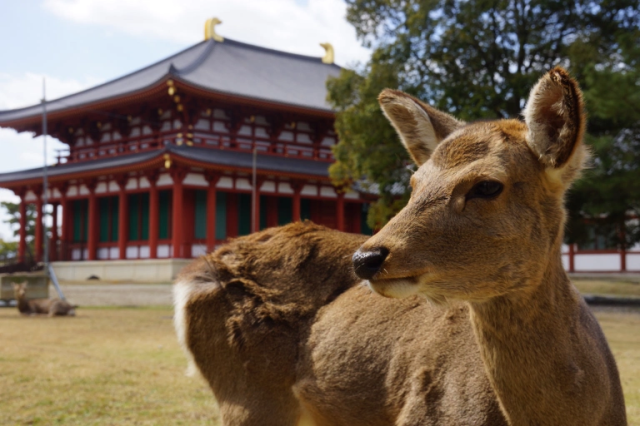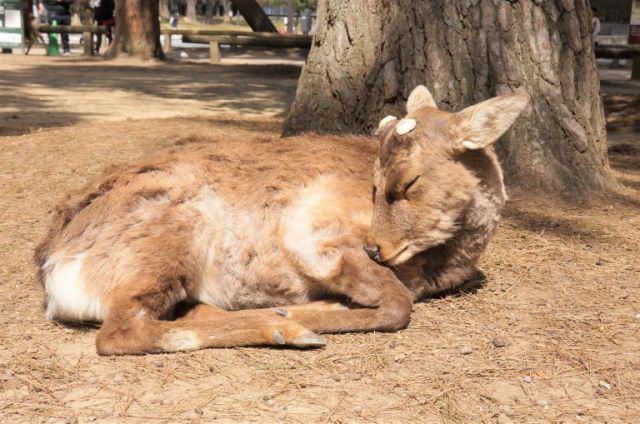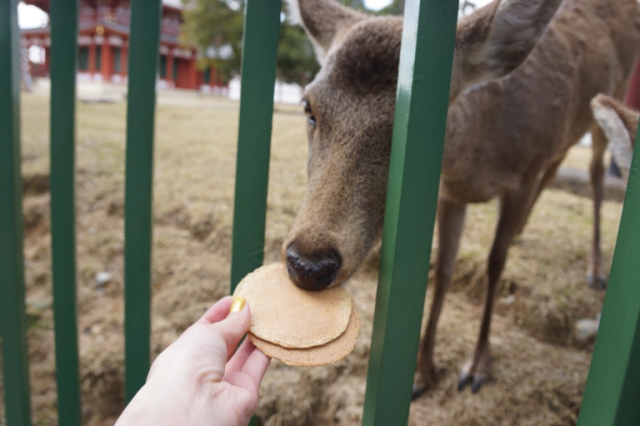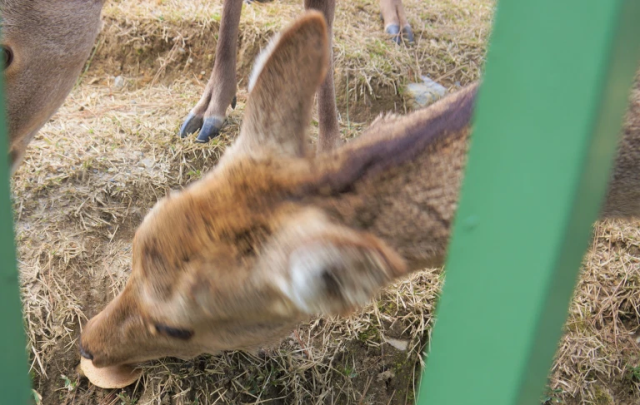
Pretty much everyone who visits Nara stops by the park to feed crackers to the deer, so are the smaller crowds leaving them hungry?
Tourism numbers are down across Japan since the start of the coronavirus outbreak, but the effect has been especially severe in central Japan. An especially large portion of the international travelers who visit the cities of Kyoto and Nara come from China, and with the coronavirus epidemic originating in Wuhan, Japan’s two former capitals have been seeing smaller crowds for roughly two months now.
It’s not just hotels, restaurants, and temples that are receiving fewer visitors, either. Nara’s biggest tourist draw is Nara Park, the expansive green space in the city center that’s home to herds of dear who freely roam the grounds. Vendors in the park sell “shika senbei,” special rice crackers visitors feed to the deer, but fewer visitors means fewer deer cracker customers. That’s making many people to worry about whether or not the deer are in danger of going hungry, especially since the animals have recently been spotted in parts of the city where they’re not such a common sight.
▼ Shika senbei
To check on how her four-legged friends are faring, last week our Japanese-language reporter and Nara resident K. Masami headed over to the park. Sure enough, there were fewer people than normal for this time of year, with the drop in non-Japanese park-goers especially noticeable. However, that park wasn’t empty. Back in her student days, before the international Japan travel boom really got into full swing, Masami used to work part-time at a nearby temple, and on her recent visit she estimates there were still more people in the park than you’d have found on an off-season midwinter day 10 years ago.
As for the deer, they didn’t look particularly distressed as they relaxed in the sun. Still, after finding a vendor, Masami paid the going-rate 200 yen (US$1.90) for a pack of deer crackers and held a disc out to one of the animals…
…who promptly trotted over and ate it.
This left Masami a little confused. The deer looked healthy enough to her, but it hadn’t hesitated to partake of the cracker. Did that mean it was hungry, or is it just standard animal nature to eat whenever the opportunity presents itself?
Being a Nara resident doesn’t grant you the power to telepathically communicate with deer, though, and so Masami couldn’t ask them directly.
▼ Or perhaps she is able to mind meld with them, but they’re too polite to think-talk while they’re eating.
Who Masami could ask, though, was the Nara Deer Preservation Foundation, the city’s local animal welfare group. So she called them up, and asked if the park’s deer are in discomfort or danger as a result of getting fewer shika senbei these days.
The foundation’s answer?
“The deer are accustomed to regularly finding their own food. The shika senbei are essentially snacks for them, so we believe they’re still getting plenty of nutrition these days.”
In retrospect, it makes a lot of sense. While Nara Park’s deer are tame, in the sense that they’re relatively calm and used to being around people, they are still wild animals. No one puts them in enclosures at night or sets out bowls of food and water for them, and while they enjoy the crackers as tasty treats, they’re not a critical necessary part of the animals’ diet. If anything, the association told us the deer might actually be enjoying the smaller crowds, making the park a quieter, less potentially stressful environment than it otherwise would be.
So don’t worry about Nara Park’s deer. They’re doing just fine.
Related: Nara Deer Preservation Foundation
Photos ©SoraNews24
[ Read in Japanese ]





 Increased tourist numbers in Nara Park are affecting the size of its deer population
Increased tourist numbers in Nara Park are affecting the size of its deer population Deer in Nara Park outnumber visitors, display baffling summer gathering behaviour
Deer in Nara Park outnumber visitors, display baffling summer gathering behaviour The poo from Nara Park’s deer is changing because of the coronavirus pandemic
The poo from Nara Park’s deer is changing because of the coronavirus pandemic Nara deer “addicted” to rice crackers, lose weight with no tourists to feed them
Nara deer “addicted” to rice crackers, lose weight with no tourists to feed them Nara deer shikadamari mystery deepens as tourists return to Nara park
Nara deer shikadamari mystery deepens as tourists return to Nara park Japan’s new difficult-to-drink-from beer glass protects your liver, but it’s a brutal experience
Japan’s new difficult-to-drink-from beer glass protects your liver, but it’s a brutal experience How to order snacks on a Shinkansen bullet train in Japan
How to order snacks on a Shinkansen bullet train in Japan Demon Slayer: Kimetsu no Yaiba gets new roller coaster attractions and food at Universal Studios Japan
Demon Slayer: Kimetsu no Yaiba gets new roller coaster attractions and food at Universal Studios Japan New Pokémon ice cream, dessert drinks, and cool merch coming to Baskin-Robbins Japan【Pics】
New Pokémon ice cream, dessert drinks, and cool merch coming to Baskin-Robbins Japan【Pics】 Burger King Japan suddenly adds Dr. Pepper and Dr. Pepper floats to its menu nationwide
Burger King Japan suddenly adds Dr. Pepper and Dr. Pepper floats to its menu nationwide Hello, cosmetics! Clinique teams up with Hello Kitty this summer for first-time collaboration
Hello, cosmetics! Clinique teams up with Hello Kitty this summer for first-time collaboration “The most Delicious Cup Noodle in history” – Japan’s French Cup Noodle wins our heart【Taste test】
“The most Delicious Cup Noodle in history” – Japan’s French Cup Noodle wins our heart【Taste test】 To combat declining birth rate, Japan to begin offering “Breeding Visas” to foreigners
To combat declining birth rate, Japan to begin offering “Breeding Visas” to foreigners Starbucks teams up with Japanese shochu brewery for a whole new coffee experience
Starbucks teams up with Japanese shochu brewery for a whole new coffee experience Studio Ghibli releases giant Totoro plushies in Japan
Studio Ghibli releases giant Totoro plushies in Japan Nintendo history you can feel – Super NES, N64, and GameCube controllers become capsule toys
Nintendo history you can feel – Super NES, N64, and GameCube controllers become capsule toys Starbucks releases a cute Frappuccino and Unicorn Cake…but not in Japan
Starbucks releases a cute Frappuccino and Unicorn Cake…but not in Japan Kyoto Tower mascot termination reveals dark side behind cute Japanese characters
Kyoto Tower mascot termination reveals dark side behind cute Japanese characters McDonald’s Japan’s Soft Twist Tower: A phantom ice cream only sold at select branches
McDonald’s Japan’s Soft Twist Tower: A phantom ice cream only sold at select branches Yabai Ramen: What makes this Japanese ramen so dangerous?
Yabai Ramen: What makes this Japanese ramen so dangerous? Finally! Nintendo Japan expands Switch 8-bit controller sales to everybody, Online member or not
Finally! Nintendo Japan expands Switch 8-bit controller sales to everybody, Online member or not Japanese government wants to build luxury resorts in all national parks for foreign tourists
Japanese government wants to build luxury resorts in all national parks for foreign tourists 10 things you should buy at 7-Eleven in Japan
10 things you should buy at 7-Eleven in Japan Studio Ghibli releases anime heroine cosplay dresses that are super comfy to wear
Studio Ghibli releases anime heroine cosplay dresses that are super comfy to wear Woman charged for driving suitcase without a license in Osaka
Woman charged for driving suitcase without a license in Osaka Studio Ghibli unveils My Neighbour Totoro miniature house model
Studio Ghibli unveils My Neighbour Totoro miniature house model Kyoto experiencing problems with foreign tourists not paying for bus fares, but not on purpose
Kyoto experiencing problems with foreign tourists not paying for bus fares, but not on purpose Fighting mild hunger with a Japanese soda that turns into jelly in the stomach【Taste test】
Fighting mild hunger with a Japanese soda that turns into jelly in the stomach【Taste test】 Studio Ghibli’s Howl’s Moving Castle tapestry unveiled in Japan for first time
Studio Ghibli’s Howl’s Moving Castle tapestry unveiled in Japan for first time McDonald’s new Happy Meals offer up cute and practical Sanrio lifestyle goods
McDonald’s new Happy Meals offer up cute and practical Sanrio lifestyle goods Sales of Japan’s most convenient train ticket/shopping payment cards suspended indefinitely
Sales of Japan’s most convenient train ticket/shopping payment cards suspended indefinitely Sold-out Studio Ghibli desktop humidifiers are back so Totoro can help you through the dry season
Sold-out Studio Ghibli desktop humidifiers are back so Totoro can help you through the dry season Japanese government to make first change to romanization spelling rules since the 1950s
Japanese government to make first change to romanization spelling rules since the 1950s Foreigner’s request for help in Tokyo makes us sad for the state of society
Foreigner’s request for help in Tokyo makes us sad for the state of society Ghibli founders Toshio Suzuki and Hayao Miyazaki contribute to Japanese whisky Totoro label design
Ghibli founders Toshio Suzuki and Hayao Miyazaki contribute to Japanese whisky Totoro label design Doraemon found buried at sea as scene from 1993 anime becomes real life【Photos】
Doraemon found buried at sea as scene from 1993 anime becomes real life【Photos】 Tokyo’s most famous Starbucks is closed
Tokyo’s most famous Starbucks is closed Princesses, fruits, and blacksmiths: Study reveals the 30 most unusual family names in Japan
Princesses, fruits, and blacksmiths: Study reveals the 30 most unusual family names in Japan Nara Park’s first baby deer of the year has been born, is totally adorable【Video】
Nara Park’s first baby deer of the year has been born, is totally adorable【Video】 Deer in Nara Park mysteriously disappear during this year’s shikadamari season
Deer in Nara Park mysteriously disappear during this year’s shikadamari season Nara deer dies with four kilos of plastic in its stomach, tourists cautioned to feed animals properly
Nara deer dies with four kilos of plastic in its stomach, tourists cautioned to feed animals properly Nara asks visitors to stop feeding the deer
Nara asks visitors to stop feeding the deer Nara deer leave park, head to station for food as tourist numbers tumble due to coronavirus
Nara deer leave park, head to station for food as tourist numbers tumble due to coronavirus During Golden Week rush, Nara deer so overwhelmed with rice crackers they wear them as hats
During Golden Week rush, Nara deer so overwhelmed with rice crackers they wear them as hats Nara unveils new vending machines that sell deer crackers
Nara unveils new vending machines that sell deer crackers Nara’s “deer cookie” rice crackers get their first price increase in 28 years
Nara’s “deer cookie” rice crackers get their first price increase in 28 years Nara considering increasing number of deer that can be killed each year, expanding culling zone
Nara considering increasing number of deer that can be killed each year, expanding culling zone Nara’s deer continue their summertime tradition of commandeering one of the city’s streets
Nara’s deer continue their summertime tradition of commandeering one of the city’s streets Adorable bowing deer in Japan shows you can be concurrently cute and courteous【Video】
Adorable bowing deer in Japan shows you can be concurrently cute and courteous【Video】 Deer killed by man with axe in Nara
Deer killed by man with axe in Nara Nara, Japanese city famous for its streets of tame deer, begins culling program within city
Nara, Japanese city famous for its streets of tame deer, begins culling program within city Green tea ice cream from Nara combines everything we love about the city into one cute dessert
Green tea ice cream from Nara combines everything we love about the city into one cute dessert Nara deer stampede into marathon, hit runner in their path
Nara deer stampede into marathon, hit runner in their path Why deer are drawn to train tracks, and how Japan is solving the problem with this simple block
Why deer are drawn to train tracks, and how Japan is solving the problem with this simple block Let’s try some “deer poop” ice cream in Nara, Japan’s city of deer!
Let’s try some “deer poop” ice cream in Nara, Japan’s city of deer!
Leave a Reply